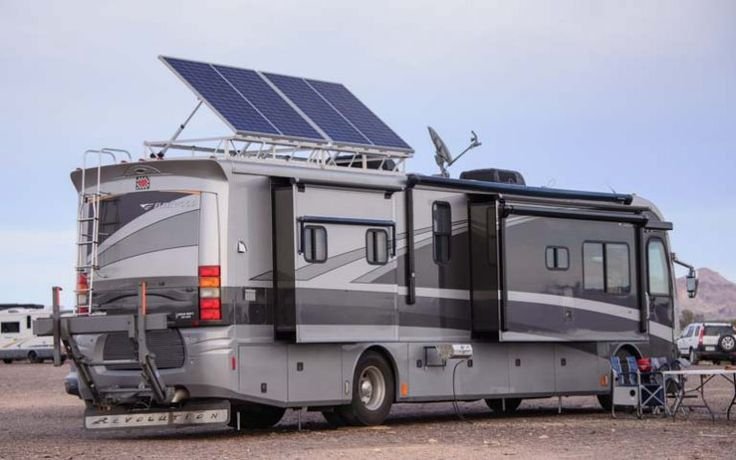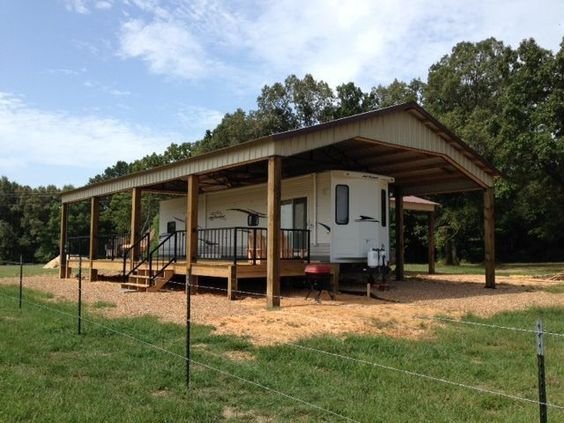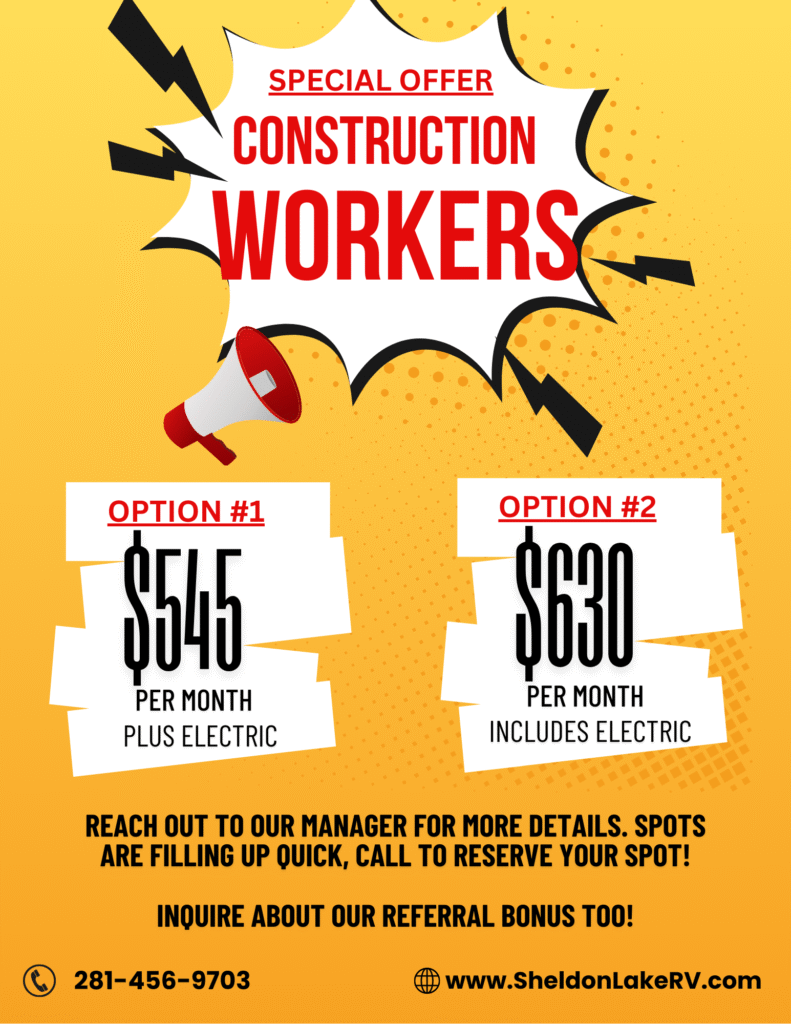Large-scale industrial projects like the Panamax initiative at Bayport require comprehensive workforce housing solutions to accommodate hundreds of temporary workers. Traditional housing options often fall short due to high costs, limited availability, and the temporary nature of these massive construction projects.
RV housing solutions provide an efficient, cost-effective alternative that can be rapidly deployed and customized to meet the specific needs of Panamax project workers in the Bayport area. These mobile units offer essential amenities while maintaining flexibility for project timelines and budget constraints.
Understanding the key features, selection criteria, and management strategies for workforce RV housing enables project managers to create comfortable living environments that support productivity and worker satisfaction throughout the construction phase.
Panamax Project Workforce Housing Needs
The Bayport area’s industrial expansion creates significant workforce housing challenges that require immediate attention. Workers face limited local accommodations and increased demand for temporary housing solutions during major project phases.
Overview of Bayport Industrial Workforce
The Panamax project draws skilled workers from across multiple states to support construction and industrial operations in Bayport. These workers include welders, crane operators, electricians, and project managers who require housing for periods ranging from several months to over a year.
Key workforce demographics include:
- Construction specialists (40%)
- Technical supervisors (25%)
- Support staff (20%)
- Administrative personnel (15%)
Most workers originate from Texas, Louisiana, Oklahoma, and Arkansas. The project typically employs 800-1,200 workers during peak construction phases. Many workers cannot commute daily due to distance from their permanent residences.
The workforce operates on rotating schedules, with some teams working extended shifts followed by time off. This creates fluctuating housing demands throughout different project phases.
Temporary Housing Demands for Projects
Peak construction periods require immediate housing solutions for hundreds of workers simultaneously. The Panamax project’s timeline creates urgent accommodation needs that traditional housing markets cannot fulfill quickly enough.
Workers need furnished units with basic utilities including electricity, water, and internet connectivity. Most require short-term leases ranging from 3-18 months depending on their specific project assignments.
Essential housing features include:
- Climate control systems
- Kitchen facilities
- Laundry access
- Parking spaces
- Security measures
The project’s remote location necessitates on-site or nearby housing options. Workers prefer accommodations within 30 minutes of job sites to minimize commute times and transportation costs.
Housing demands fluctuate based on construction milestones, weather conditions, and project delays. Flexible housing solutions that can scale up or down become essential for cost-effective workforce management.
Challenges in Securing Local Accommodations
Bayport’s limited hotel inventory cannot accommodate long-term workforce housing needs at reasonable rates. Most area hotels lack extended-stay amenities and become prohibitively expensive for multi-month assignments.
Local apartment complexes have insufficient vacancy rates to house hundreds of additional temporary residents. Many properties require long-term leases that exceed worker assignment durations or end before project completion.
The area’s housing stock lacks the immediate availability needed for rapid workforce deployment. Traditional rental processes involving credit checks, deposits, and lease negotiations create delays that conflict with project timelines.
Primary accommodation barriers:
- Limited inventory of suitable units
- High costs for extended stays
- Inflexible lease terms from local landlords
- Geographic distance from job sites
Companies like Sheldon Lake RV provide specialized workforce housing solutions that address these market gaps through mobile and temporary housing options designed specifically for industrial projects.
RV Housing Solutions for Bayport Workers
RV housing provides practical accommodations for industrial crews working on Panamax projects in the Bayport area. These solutions offer mobility, cost efficiency, and customizable living spaces that address the unique challenges of workforce housing in industrial settings.
Types of RVs Suitable for Workforce Housing
Travel trailers represent the most common choice for workforce housing applications. These units range from 20 to 40 feet in length and accommodate 2-6 workers depending on configuration. They require hookups for electricity, water, and sewer connections.
Fifth-wheel trailers offer enhanced stability and larger living spaces. Their unique hitch design provides better weight distribution during transport. These units typically measure 25-45 feet and feature separate bedroom areas.
Motorhomes Class A deliver premium accommodations with built-in engines and luxury amenities. They work well for supervisory staff or specialized crews requiring mobile command centers.
Park model RVs provide semi-permanent housing solutions. These units measure up to 400 square feet and offer residential-style amenities. Companies like Sheldon Lake RV at 16925 Crosby Fwy, Houston, TX 77049 (+1 281-456-9703) specialize in workforce-appropriate units.
Toy haulers convert cargo areas into additional sleeping quarters. This versatility makes them suitable for crews transporting equipment or requiring extra storage space.
Advantages of RV Accommodations for Crews
Cost efficiency stands out as the primary benefit. RV rentals cost significantly less than hotel accommodations for extended stays. Daily rates decrease substantially with long-term contracts.
Proximity to work sites eliminates lengthy commutes. Workers can position RVs within walking distance of industrial facilities. This reduces transportation costs and improves punctuality.
Kitchen facilities allow crews to prepare meals rather than relying on restaurants. Each unit includes refrigeration, cooking surfaces, and dining areas. This feature reduces meal expenses by 60-70% compared to eating out.
Privacy and comfort exceed hotel accommodations. Workers have dedicated spaces for rest and personal activities. Multiple bedrooms separate sleeping areas from common spaces.
Reduced liability occurs when housing sits on-site. Companies avoid worker transportation risks between off-site accommodations and job locations.
Customization and Floor Plan Options
Bunkhouse configurations maximize sleeping capacity with dedicated bunk rooms. These layouts accommodate 4-8 workers in compact spaces. They work well for entry-level crew housing.
Master suite arrangements provide private accommodations for supervisors or married couples. These units feature separate bedrooms with king-size beds and private bathrooms.
| Layout Type | Occupancy | Best For |
|---|---|---|
| Single Bedroom | 2 people | Supervisors |
| Bunkhouse | 4-8 people | Crew housing |
| Multi-bedroom | 4-6 people | Mixed groups |
Kitchen upgrades include residential appliances, extended counter space, and additional storage. Some units feature islands or breakfast bars for communal dining.
Technology packages add high-speed internet, multiple TV connections, and workstation areas. These features support remote communication and training requirements.
Climate control systems ensure year-round comfort. Enhanced insulation and dual-zone heating/cooling systems maintain consistent temperatures.
Comparison With Traditional Housing
Setup time favors RV solutions significantly. Traditional temporary buildings require 4-6 weeks for installation. RVs deploy within 24-48 hours after site preparation.
Mobility represents a key advantage. Projects can relocate RV housing as work zones shift. Traditional structures require complete reconstruction at new locations.
| Factor | RV Housing | Traditional Housing |
|---|---|---|
| Setup time | 1-2 days | 4-6 weeks |
| Monthly cost per person | $800-1,200 | $1,500-2,500 |
| Relocation capability | High | None |
Maintenance responsibilities differ substantially. RV providers handle repairs and servicing. Traditional housing requires dedicated maintenance staff or service contracts.
Utility connections prove simpler with RVs. Standard hookups suffice for most installations. Traditional buildings often require extensive infrastructure development.
Capacity flexibility allows easy scaling. Additional RVs accommodate crew size changes. Traditional housing commits to fixed occupancy numbers.
Key Features and Amenities of Workforce RVs
Workforce RVs designed for Panamax project housing incorporate commercial-grade construction with specialized amenities for multi-person occupancy. These units feature reinforced building materials, expanded sleeping configurations, and integrated utility systems designed for extended deployment periods.
Durability and Construction Standards
Commercial workforce RVs utilize heavy-duty steel frames with welded joints rather than standard recreational vehicle construction methods. The exterior walls feature multi-layer insulation systems with vapor barriers to withstand harsh industrial environments.
Flooring systems incorporate commercial-grade vinyl or laminate materials rated for high-traffic use. These materials resist moisture, chemicals, and heavy foot traffic common in workforce housing applications.
Structural reinforcements include:
- Reinforced axles and suspension systems
- Commercial-grade tires rated for frequent transport
- Enhanced roof structures for equipment mounting
- Corrosion-resistant exterior cladding
Windows feature tempered glass with security screens and heavy-duty locks. Door systems use commercial hardware with reinforced frames to handle frequent use by multiple occupants.
Sleeping Capacity and Comfort
Multi-sleeping workforce trailers accommodate 8-16 occupants depending on configuration. Bunk bed systems use commercial-grade steel frames with individual privacy curtains and personal storage compartments.
Each sleeping area includes individual LED reading lights and 12V charging outlets. Mattresses meet commercial fire safety standards while providing adequate comfort for extended stays.
Typical sleeping arrangements include:
- Double-stacked bunk configurations
- Individual storage lockers (2x2x1 feet)
- Personal climate control vents
- Privacy partitions between sleeping areas
Common areas feature convertible seating and dining spaces. Tables fold down from walls to maximize floor space during non-meal periods.
Integrated Utilities and Climate Control
Workforce RVs feature dual bathroom facilities with commercial-grade fixtures and adequate hot water capacity for multiple users. Each unit includes separate shower stalls with non-slip flooring and grab bars.
Electrical systems provide 30-50 amp service with individual breakers for major appliances. LED lighting throughout reduces power consumption while providing adequate illumination.
Climate control systems include:
- Multi-zone HVAC with individual thermostats
- High-capacity air conditioning units
- Propane heating systems with safety shutoffs
- Exhaust fans in bathrooms and kitchen areas
Laundry facilities feature commercial-grade washers and dryers sized for workforce capacity. Kitchen areas include full-size refrigerators, microwaves, and adequate counter space for meal preparation.
Fresh water tanks hold 100-150 gallons with corresponding gray and black water capacity. External connections allow for permanent utility hookups at project sites.
Selecting and Managing RV Housing for Projects
Successful RV housing deployment for Panamax projects requires careful evaluation of site logistics, acquisition methods, and ongoing operational support. Project managers must balance proximity requirements with infrastructure capabilities while establishing clear management protocols.
Site Selection and Proximity Considerations
Location proximity directly impacts worker productivity and project costs. Sites within 15-30 minutes of the worksite reduce commute times while maintaining separation from industrial operations.
Infrastructure assessment determines site viability. Essential utilities include:
- 30/50-amp electrical service
- Water and sewer connections
- Internet and cellular coverage
- Emergency vehicle access
Ground conditions must support RV stabilization and prevent settling. Level terrain with proper drainage prevents structural issues during extended deployments.
Security considerations include lighting, fencing, and controlled access points. Remote locations require additional security measures to protect equipment and personnel.
Local zoning regulations may restrict temporary housing placement. Permit requirements vary by municipality and can affect project timelines significantly.
Rental, Lease, and Purchase Options
Short-term rentals work best for projects under six months. Daily rates range from $75-150 depending on RV size and amenities included.
Monthly lease agreements provide cost advantages for projects lasting 6-18 months. Rates typically decrease 20-30% compared to daily rentals when extended terms are negotiated.
Purchase options become cost-effective for projects exceeding 18 months or companies with recurring housing needs. New RVs cost $50,000-150,000 while used units start around $25,000.
Fleet management companies like those serving industrial projects offer maintenance-included packages. These arrangements eliminate repair responsibilities and ensure consistent availability.
Insurance considerations differ by acquisition method. Rental agreements typically include coverage while purchased units require separate commercial policies.
Management and On-Site Support
Designated housing coordinators handle daily operations and worker concerns. This role includes maintenance scheduling, utility monitoring, and conflict resolution between residents.
Maintenance protocols ensure consistent living conditions. Weekly inspections identify issues before they impact habitability or require costly emergency repairs.
Utility management includes monitoring usage patterns and coordinating service interruptions. Backup power systems may be necessary for critical locations without reliable electrical service.
House rules establish quiet hours, visitor policies, and common area responsibilities. Clear guidelines prevent disputes and maintain professional living environments.
Emergency procedures must address medical situations, severe weather, and evacuation protocols. Coordination with local emergency services ensures rapid response capabilities when needed.
Frequently Asked Questions
Workers seeking RV housing solutions for Bayport projects often have questions about pricing, floor plans, and purchasing options. The following addresses common inquiries about RV workforce housing specifications and availability.
What are the top-rated RV options for Bayport workforce housing?
Travel trailer bunkhouses and fifth wheel units designed by Recreation By Design offer proven accommodation solutions for industrial workforce housing needs.
How much does a standard workforce RV cost?
Standard workforce RV units typically range from $45,000 to $85,000 depending on size, features, and manufacturer specifications.
What are the various floor plans available for Travel by Design RV bunkhouses?
Travel by Design offers multiple bunkhouse configurations including single and double occupancy layouts with integrated kitchen, bathroom, and sleeping quarters designed for extended workforce stays.
Where can one find pre-owned crew bunkhouse trailers on sale?
Pre-owned crew bunkhouse trailers are available through specialized dealers like Sheldon Lake RV, industrial equipment auctions, and direct sales from companies completing workforce housing projects.
Who is the current owner of Gulf Stream RV manufacturing?
Gulf Stream Coach operates as a subsidiary of Rev Group, which acquired the manufacturer to expand their recreational vehicle portfolio.
Can RVs be classified as mobile homes for permanent residence?
RVs can serve as temporary workforce housing but typically require special permits and compliance with local zoning regulations for extended residential use beyond standard camping periods.




